PARK 1
PARK 1®
PARK 1 to pierwszy aparat, stanowiący połączenie klasycznego autorefraktometru i keratometru oraz bezkontaktowego pachymetru opartego na zasadzie Scheimpfluga.
Intuicyjny system naprowadzania, wyświetlanego na ekranie LCD o przekątnej 5,7 cala, możliwość śledzenia ruchów gałki ocznej, a także ergonomiczna konstrukcja umożliwiają wykonanie szybkich i wiarygodnych pomiarów. Urządzenie jest wyposażone w różne tryby pomiarowe (PARK/ARK/P/K) z możliwością wyboru metody odpowiedniej do danej sytuacji. Sprawdzona technika Scheimpfluga określa grubość rogówki w poziomej 4-milimetrowej strefie. W uzupełnieniu doskonałych parametrów technicznych, dzięki kompaktowym wymiarom i zasilaczowi zewnętrznemu aparat jest niezwykle łatwy użyciu i przystosowany do montażu na unitach okulistycznych i stolikach z regulowaną wysokością.
Up to Three Measurements in a Matter of Seconds
- Auto-refractor
- Keratometer
- Pachymeter (optional)
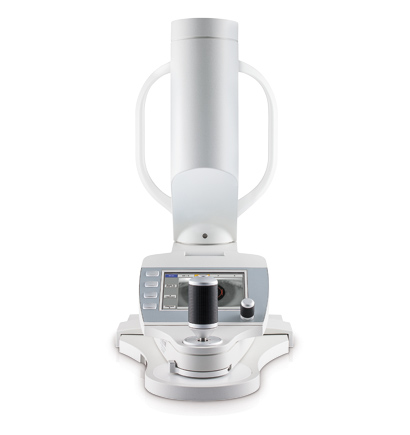
Contact Lens Database
The integrated contact lens database for soft contact lenses (sph, tor, multifocal) supplies a list of recommendations based on the objectively measured data. Individually adjustable parameters, such as subjective refraction, wear duration and contact lens type, allow the patient’s preferences to be taken into consideration.
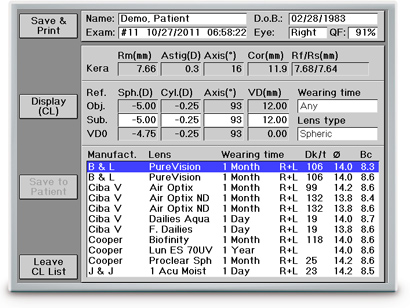
Touchscreen
Menu navigation on the touchscreen ensures intuitive and easy operation.
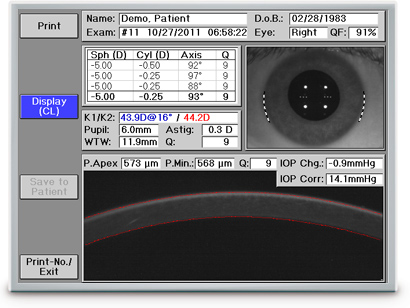
Automatic Measurement Release
The automatic measurement release provides reproducible measuring results in a matter of seconds:
- Objective refraction values
- Keratometer values
- Pachymetry in the apex
- Diameter of the cornea
- Pupil diameter
- Far PD
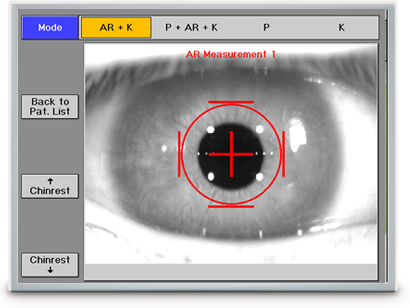
RED DOT Award – Design-Prize
The PARK 1® won the RED DOT Award for its slim, ergonomic, space-saving design.
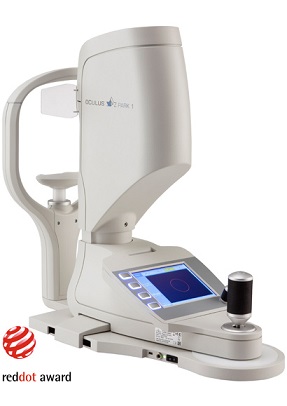
Auto-Refractometer
Measurement of the objective refraction data in seconds, with reproducible results. Specification of a quality factor provides information about the usability or the quality of the conducted measurement. The reliably determined data come very close to the subjective refraction.

Keratometer
The integrated, distance-independent keratometer guarantees measurement of the central radii with the greatest of accuracy.
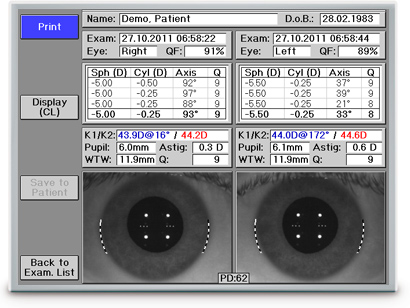
Pachymeter
The optional, non-contact pachymetry is based on Scheimpflug images and makes precise non-contact measurement of the corneal thickness possible.
- Measurement of the corneal thickness in the apex and the minimum corneal thickness in the entire measuring area
- Measurement of 600 absolute height values on a horizontal 4 mm cut through the apex
- Presentation of the corneal thickness profile in the form of a diagram. Automatic adjustment of the scaling of the Pachymetry measurements for better presentation of the individual thicknesses
- Pachymetry-based correction of the separately measured intraocular pressure
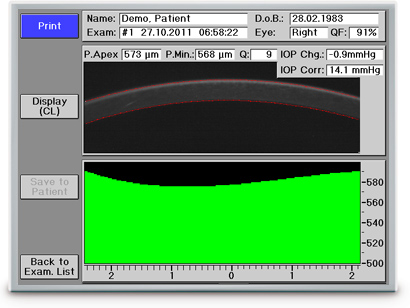
Optional Database for Soft Contact Lenses with Fitting Recommendation
- Fitting recommendation for soft contact lenses (based on the objective refraction, corneal diameter and central corneal radii measurements)
- Adaptable list of contact lenses in the unit
- The stabilization axis can be taken into account for fitting toric lenses
- Over-refraction support
- OxiMap® – Visualization of the oxygen transmissibility of soft contact lenses
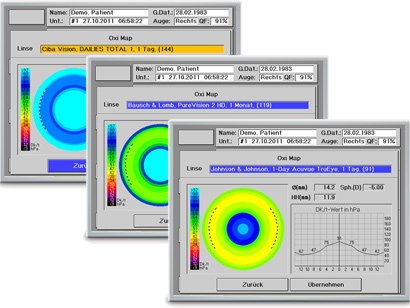
Automatic Measurement Release
Thanks to the automatic measurement release, you always get reproducible measuring results. The diameters of the pupil and cornea, and the pupillary distance are determined automatically. Manual measurement is no longer necessary.

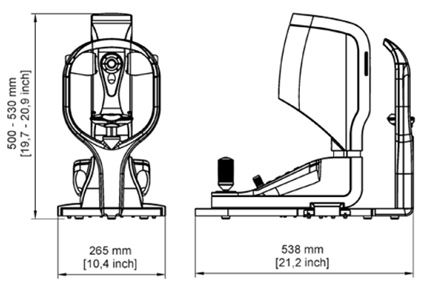
| Measuring range | 200 bis 1 200 μm |
| Number of evaluated measuring points | 600 |
| Measuring time | Approx. 1 sec. |
| Light source | Blue LEDs (455 nm UV-free) |
| Corneal vertex distance (CVD) | 0; 10.5; 12; 13.75; 15; 16.5 mm |
| Sphere | -20 to +22 dpt (CVD = 12 mm) (choice of 0.01-; 0.12- or 0.25 dpt increments) |
| Cylinder | 10 dpt (CVD = 12 mm) (choice of 0.01-; 0.12- and 0.25 dpt increments) |
| Axis | 0° to 180° (in 1° increments) |
| Smallest measurable pupil diameter | 2.5 mm |
| Fixation image | Hot air balloon in a landscape |
| Measuring range | 9 to 99 dpt 3 to 38 mm |
| Accuracy | ± 0.1 dpt |
| Reproducibility | ± 0.1 dpt |
| Far PD | 20 to 80 mm (in 1 mm-increments) |
| Corneal diameter measuring range | 10 to 14 mm (in 0.1 mm-increments) |
| Pupil diameter measuring range | 1 to 8 mm (in 0.1 mm-increments) |
| Auto alignment | Automatic height alignment (y-direction) |
| Auto release | Automatic measurement release |
| Working distance | Approx. 36 mm (1.4 in) |
| Dimensions H x W x D | 500 x 265 x 538 mm (19.7 x 10.4 x 21.1 in) |
| Weight | 12 kg (26.4 lbs) |
| Power supply | 100 – 240 V AC, 50 – 60 Hz |
| Printer | Thermal printer |
| Display | TFT – LCD 5.7″ (Touchscreen) |
| Interface | USB |
| Standard accessories | Printer paper, power cable, dust cover, chin rest paper, USB mini cable |



